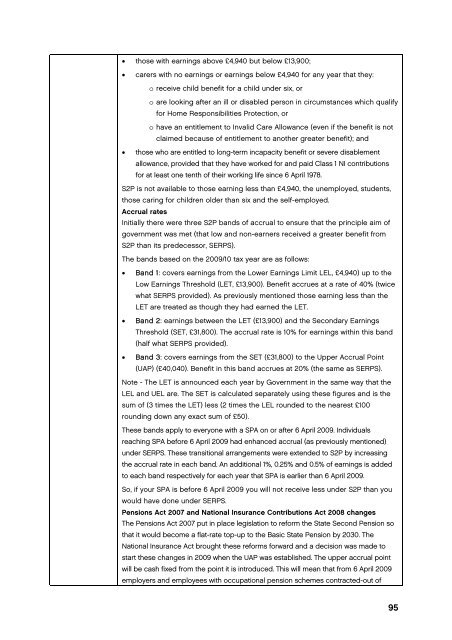Simplification is the key - Centre for Policy Studies
Simplification is the key - Centre for Policy Studies
Simplification is the key - Centre for Policy Studies
Create successful ePaper yourself
Turn your PDF publications into a flip-book with our unique Google optimized e-Paper software.
those with earnings above £4,940 but below £13,900;<br />
<br />
carers with no earnings or earnings below £4,940 <strong>for</strong> any year that <strong>the</strong>y:<br />
o receive child benefit <strong>for</strong> a child under six, or<br />
o are looking after an ill or d<strong>is</strong>abled person in circumstances which qualify<br />
<strong>for</strong> Home Responsibilities Protection, or<br />
o have an entitlement to Invalid Care Allowance (even if <strong>the</strong> benefit <strong>is</strong> not<br />
claimed because of entitlement to ano<strong>the</strong>r greater benefit); and<br />
<br />
those who are entitled to long-term incapacity benefit or severe d<strong>is</strong>ablement<br />
allowance, provided that <strong>the</strong>y have worked <strong>for</strong> and paid Class 1 NI contributions<br />
<strong>for</strong> at least one tenth of <strong>the</strong>ir working life since 6 April 1978.<br />
S2P <strong>is</strong> not available to those earning less than £4,940, <strong>the</strong> unemployed, students,<br />
those caring <strong>for</strong> children older than six and <strong>the</strong> self-employed.<br />
Accrual rates<br />
Initially <strong>the</strong>re were three S2P bands of accrual to ensure that <strong>the</strong> principle aim of<br />
government was met (that low and non-earners received a greater benefit from<br />
S2P than its predecessor, SERPS).<br />
The bands based on <strong>the</strong> 2009/10 tax year are as follows:<br />
<br />
<br />
<br />
Band 1: covers earnings from <strong>the</strong> Lower Earnings Limit LEL, £4,940) up to <strong>the</strong><br />
Low Earnings Threshold (LET, £13,900). Benefit accrues at a rate of 40% (twice<br />
what SERPS provided). As previously mentioned those earning less than <strong>the</strong><br />
LET are treated as though <strong>the</strong>y had earned <strong>the</strong> LET.<br />
Band 2: earnings between <strong>the</strong> LET (£13,900) and <strong>the</strong> Secondary Earnings<br />
Threshold (SET, £31,800). The accrual rate <strong>is</strong> 10% <strong>for</strong> earnings within th<strong>is</strong> band<br />
(half what SERPS provided).<br />
Band 3: covers earnings from <strong>the</strong> SET (£31,800) to <strong>the</strong> Upper Accrual Point<br />
(UAP) (£40,040). Benefit in th<strong>is</strong> band accrues at 20% (<strong>the</strong> same as SERPS).<br />
Note - The LET <strong>is</strong> announced each year by Government in <strong>the</strong> same way that <strong>the</strong><br />
LEL and UEL are. The SET <strong>is</strong> calculated separately using <strong>the</strong>se figures and <strong>is</strong> <strong>the</strong><br />
sum of (3 times <strong>the</strong> LET) less (2 times <strong>the</strong> LEL rounded to <strong>the</strong> nearest £100<br />
rounding down any exact sum of £50).<br />
These bands apply to everyone with a SPA on or after 6 April 2009. Individuals<br />
reaching SPA be<strong>for</strong>e 6 April 2009 had enhanced accrual (as previously mentioned)<br />
under SERPS. These transitional arrangements were extended to S2P by increasing<br />
<strong>the</strong> accrual rate in each band. An additional 1%, 0.25% and 0.5% of earnings <strong>is</strong> added<br />
to each band respectively <strong>for</strong> each year that SPA <strong>is</strong> earlier than 6 April 2009.<br />
So, if your SPA <strong>is</strong> be<strong>for</strong>e 6 April 2009 you will not receive less under S2P than you<br />
would have done under SERPS.<br />
Pensions Act 2007 and National Insurance Contributions Act 2008 changes<br />
The Pensions Act 2007 put in place leg<strong>is</strong>lation to re<strong>for</strong>m <strong>the</strong> State Second Pension so<br />
that it would become a flat-rate top-up to <strong>the</strong> Basic State Pension by 2030. The<br />
National Insurance Act brought <strong>the</strong>se re<strong>for</strong>ms <strong>for</strong>ward and a dec<strong>is</strong>ion was made to<br />
start <strong>the</strong>se changes in 2009 when <strong>the</strong> UAP was establ<strong>is</strong>hed. The upper accrual point<br />
will be cash fixed from <strong>the</strong> point it <strong>is</strong> introduced. Th<strong>is</strong> will mean that from 6 April 2009<br />
employers and employees with occupational pension schemes contracted-out of<br />
95

















